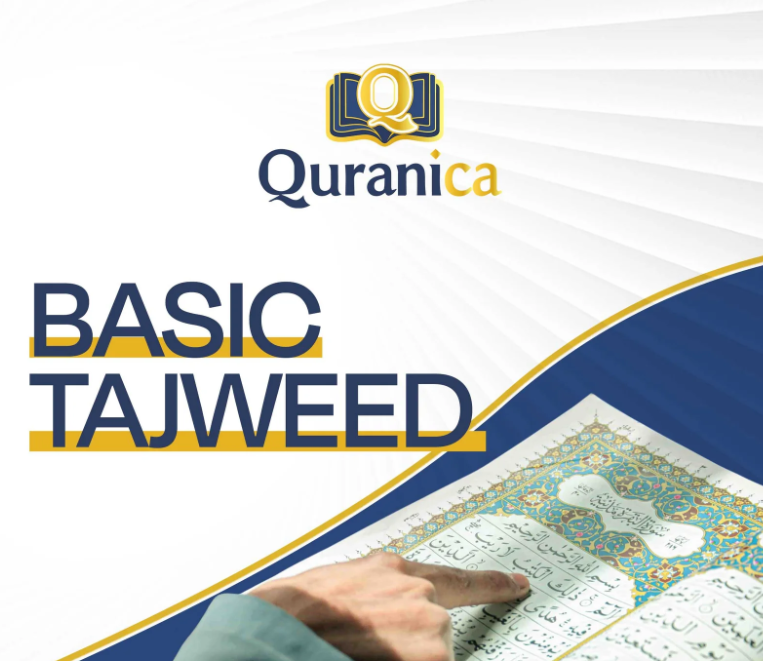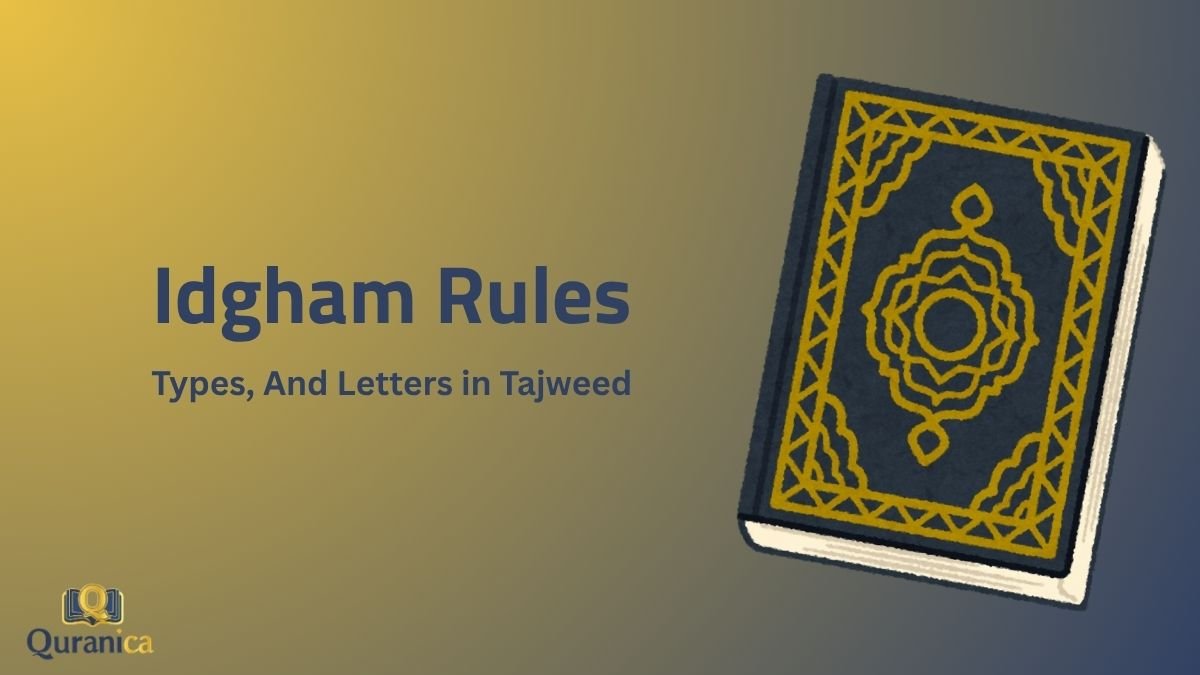Idgham in Tajweed refers to merging a Noon Saakinah or Tanween into the next letter for smoother Quranic recitation. It has two main forms: with Ghunnah (nasal sound) for letters like Yaa and Meem, and without Ghunnah for Laam and Raa. Variants include complete and incomplete merging, as well as special types like Idgham Shafawi. Learners must watch out for common errors and exceptions like Izhar Mutlaq.
When we listen to a masterful Qari (reciter of the Quran), we notice a beautiful flow, a seamless connection between words that makes the recitation captivating.
One of the most fundamental rules that creates this beautiful melody is Idgham (ادغام). Mastering Idgham is a milestone.
Idgham takes your recitation from a basic, letter-by-letter reading to a fluid and correct pronunciation, just as the Angel Jibreel taught it to our Prophet Muhammad (peace be upon him).
What is Idgham?
Idgham is the “merging” of two letters into one. In recitation, we are not just skipping a letter; we are physically inserting one letter into the next so they are pronounced as a single, emphasized letter.
Imagine you have two streams of water flowing side-by-side. Idgham is like one of those streams flowing into the other, becoming a single, stronger stream.
1. The Linguistic Definition of Idgham
Linguistically, the Arabic word Idgham comes from the root verb أَدْغَمَ (Adghama). It literally means “to insert” or “to merge something into something else.”
For instance, a native Arab might say, “أَدْغَمْتُ اللِّجَامَ فِي فَمِ الْفَرَسِ” which means, “I inserted the bridle into the horse’s mouth.” It’s a physical act of entering one thing into another.
2. The Meaning of Idgham in Tajweed
In the science of Tajweed, Idgham is defined as the meeting of a non-voweled letter with a voweled letter. This meeting causes the two letters to become one single, stressed (mushaddad) letter of the second kind.
This means the first letter’s sound disappears, and the second letter is pronounced with a shaddah.
Pronunciation of Idgham in Tajweed When and Where?
The rule of Idgham is not random. It is one of the four essential rulings that apply specifically when a Noon Saakinah (نْ) or a Tanween (ـًـــٍـــٌ) is followed by certain letters of the Arabic alphabet.
Understanding this context is the first step toward identifying where and when to apply the rule.
Idgham as a Part of Rules of Noon Saakinah and Tanween
When you see a Noon Saakinah or a Tanween in the Quran, you must pause for a fraction of a second and see which letter comes after it. Depending on that next letter, one of four rules will apply.
- Izhar (الْإِظْهَار): The Clarity or Pronouncing Clearly. The Noon sound is pronounced fully and clearly without any merging or nasalization.
- Idgham (الْإِدْغَام): The Merging. The Noon sound is merged into the next letter, which we will detail in this article.
- Iqlab (الْإِقْلَاب): The Conversion. The Noon sound is converted into a light ‘m’ sound.
- Ikhfa (الْإِخْفَاء): The Hiding. The Noon sound is partially hidden or veiled, pronounced with a light nasal sound (ghunnah).
A foundational understanding of all four of these rules is the key to proper recitation. For those just starting their journey, a structured program like the Learn Tajweed for beginners Course can build this essential groundwork.

Idgham of Noon Saakinah and Tanween
Here is the core principle you need to remember: If a Noon Saakinah (نْ) or Tanween (ـًـــٍـــٌ) is followed by one of the six specific letters of Idgham, then the rule of Idgham must be applied.
The Noon sound is not pronounced clearly; it merges into the following letter.
Idgham Letters
The scholars of Tajweed have conveniently grouped the six letters of Idgham into a single, easy-to-remember mnemonic word: يَرْمَلُون (Yarmaloon).
The six letters are:
- ي (Yaa)
- ر (Raa)
- م (Meem)
- ل (Laam)
- و (Waw)
- ن (Noon)
Types of Idgham
Now we get into the beautiful details. The primary way we categorize Idgham is based on whether a Ghunnah (غُنَّة) is performed.
1. Idgham with Ghunnah and Without Ghunnah
In Tajweed, Idgham means merging a Noon Saakinah (نْ) or Tanween (ــً، ــٍ، ــٌ) into the following letter. This merging comes in two types:
A. Idgham with Ghunnah (Nasally Merged)
This happens when Noon Saakinah or Tanween is followed by one of these four letters:
ي، ن، م، و (found in the word “ينمو”).
The Noon is merged with a nasal sound (ghunnah) held for two counts.
Examples:
- فَمَن يَّعْمَلْ → Famay-ya’mal (with Ghunnah on Yaa)
- مِن وَّالٍ → Miw-waalin (with Ghunnah on Waw)
- صِرَاطًا مُّسْتَقِيمًا → Siraatam-mustaqeeman (with Ghunnah on Meem)
- عَن نَّفْسٍ → An-nafsin (with Ghunnah on Noon)
B. Idgham without Ghunnah (Completely Merged)
This occurs when Noon Saakinah or Tanween is followed by ل or ر. Here, the Noon sound disappears completely—no nasalization at all.
Examples:
- هُدًى لِّلْمُتَّقِينَ → Hudal-lilmuttaqeen (merged into Laam)
- مِّن رَّبِّهِمْ → Mir-Rabbihim (merged into Raa)
Read also: Idgham with Ghunnah And Without Ghunnah With Examples
2. Idgham Taam (Complete Merging) – الإدغام التام
This is when the Noon Saakinah or Tanween completely disappears into the next letter, and you only pronounce the second letter with a Shaddah.
This happens with these 4 letters: ل، ر، ن، م.
Examples:
- مِّن لَّدُنْهُ → Mil-ladunhu (Noon merges fully into Laam)
- لَن نَّصْبِرَ → Lan-nasbira (Noon merges fully into Noon, Ghunnah comes from the second Noon)
Read also: Idgham Taam/Kalmil & Idgham Naqis In Tajweed With Examples
3. Idgham Naqis (Incomplete Merging) – الإدغام الناقص
Here, the body of the Noon merges, but the nasal sound (Ghunnah) remains for two counts.
It happens only with و (Waw) and ي (Yaa).
Examples:
- مِن وَاقٍ → Miw-waaqin (Noon merges, Ghunnah remains with Waw)
- مَن يَقُولُ → May-yaqoolu (Noon merges, Ghunnah remains with Yaa)
Exception: Izhar Mutlaq (Absolute Clarity)
If a Noon Saakinah is followed by an Idgham letter within the same word, no merging happens. The Noon is pronounced clearly.
Only 4 words apply:
- دُنْيَا
- بُنْيَانٌ
- صِنْوَانٌ
- قِنْوَانٌ
These are preserved for meaning and structure.
4. Idgham Shafawi (Merging Meem Saakin) – إدغام شفوي
Idgham Shafawi is the merging of Meem Saakinah (مْ) into a voweled Meem (مَ / مِ / مُ) that comes after it.
When this happens, the two Meems become one stressed Meem with Ghunnah (a nasal sound), pronounced clearly.
It’s called “Shafawi” because both Meems are articulated with the lips.
Examples from the Quran:
- “وَلَكُم مَّا كَسَبْتُمْ”
Wa lakum-ma kasabtum
(Surah Al-Baqarah 2:134)
→ The Meem in لَكُمْ merges into the Meem in مَّا with Ghunnah. - “وَءَامَنَهُم مِّنْ خَوْفٍ”
Wa aamanahum-min khawf
(Surah Quraysh 106:4)
→ The Meem in هُم merges into the Meem in مِّنْ smoothly with nasalization.
Read also: Idgham Shafawi إدغام شفوي With Examples in Tajweed
5. Idgham Mutamathilayn (Merging Identical Letters)
This occurs when two identical letters meet—one with sukoon (ْ) and the other with a vowel. The first is merged into the second, pronounced as a single stressed letter.
Examples:
- “اضْرِب بِّعَصَاكَ” → Idhrib-bi‘asaak
The two Baas (بْ + بِ) merge into one بّ with a shaddah. - “قُل لَّا أَسْأَلُكُمْ” → Qul-laa
The Laam (لْ) in Qul merges into the next Laam (لَّا).
6. Idgham Mutajanisayn (Merging Similar Letters)
This involves two letters from the same articulation point (makhraj), like Daal (د) and Taa (ت). When the first has sukoon and the second is voweled, the first merges into the second.
Examples:
- “قَد تَّبَيَّنَ” → Qat-tabayyana
The Daal (دْ) merges into the Taa (تّ). - “قَالَت طَّائِفَةٌ” → Qalat-taa’ifah
The Taa (تْ) merges into the Taa (طّ).
7. Idgham Mutaqaribayn (Merging Close Letters)
This occurs between two letters that are close in articulation, like Qaaf (ق) and Kaaf (ك), or Laam (ل) and Raa (ر).
Examples:
- “قُل رَّبِّ” → Qur-rabbi
The Laam (لْ) merges into the Raa (رّ). - “أَلَمْ نَخْلُقكُّم” → Alam nakhluk-kum
The Qaaf (قْ) merges into the Kaaf (كّ) with a shaddah.
Read also: Idgham Mutamathilayn, Mutajanisayn, And Mutaqaribayn With Examples In Tajweed
Common Mistakes to Avoid When Pronouncing Idgham
As you begin to apply the rules of Idgham, it’s natural to make a few mistakes along the way. The journey to perfecting recitation is one of awareness and correction.
Being mindful of these common pitfalls will help you beautify your Quranic reading much faster.
Here are some of the most frequent errors I hear from students:
1. Cutting the Ghunnah Too Short or Holding it Too Long
The Ghunnah in Idgham with Ghunnah has a specific, beautiful timing of approximately two counts.
A common error is to either rush through it, barely producing a nasal sound, or to hold it for three or four counts, which disrupts the flow of the recitation. The correct sound is balanced—neither hurried nor dragged out.
2. Applying Ghunnah on Idgham without Ghunnah
This is perhaps the most significant mistake. When you see a Noon Saakinah or Tanween before a Laam (ل) or a Raa (ر), the merging must be complete and clean. There should be absolutely no trace of a nasal sound.
For example, in “mir-Rabbihim,” if you can hear even a slight hum or nasalization (min-Rabbihim), the rule has been applied incorrectly.
3. Pronouncing the Noon Before a Waw or Yaa
For Idgham Naqis (incomplete merging with و and ي), the goal is not to say the Noon letter clearly and then the Yaa or Waw. The mistake is to say, for example, “man ya’mal.”
The correct way is to let the sound of the Noon’s Ghunnah flow seamlessly into the next letter, making a smooth transition: “may-ya’mal.” The Noon letter itself is silent; only its nasal quality remains.
4. Making a Mouth Sound for the Ghunnah
The Ghunnah is a pure sound that resonates entirely in the nasal passage (al-khayshum). Some learners mistakenly try to produce the sound from their mouth, which results in a muffled or incorrect tone.
A simple test: try to say the Ghunnah while gently pinching your nose shut. If the sound stops completely, you are doing it correctly. If you can still make a sound from your mouth, you need to redirect the resonance to your nasal passage.
5. Forgetting the Exception of Izhar Mutlaq
It is a frequent error for beginners to see a Noon Saakinah next to a Yaa or Waw and immediately apply Idgham. However, they forget the crucial exception: this rule does not apply within a single word.
Applying Idgham to words like دُنْيَا (Dunya) or صِنْوَانٌ (Sinwan) is a major error (lahn jaliyy) that must be avoided to preserve the word’s meaning. Always pronounce the Noon clearly in these specific cases.
Perfect Your Tajweed with Quranica
The rules of Tajweed, like Idgham, are the keys to unlocking the divine beauty of the Quran’s sound.
It is a trust (amanah) upon us to recite the words of Allah as they were revealed. Reading is good, but reciting correctly and beautifully is the goal.
At Quranica, we believe that every student deserves to learn from the best. Our instructors are not just tutors; they are inheritors of a sacred tradition. They are:
- Native Arab tutors who are proud graduates of the prestigious Al-Azhar University.
- Ijazah-holders with certified chains of transmission (Sanad) to teach the Quran.
- Highly experienced in teaching Arabic, the Quran, and its sciences to non-native speakers with patience and clarity.
We have structured our programs to be both excellent and accessible, with competitive and affordable pricing for everyone. Whether you are a beginner or an advanced student, we have a path for you.
- Learn Quran with Tajweed (for all levels)
- Quran Memorization (Hifz) Programs
- Ijazah Course
- Islamic Studies
- Ten Qirat
- Arabic Lessons for Beginners
Explore our full range of courses.
Join a Quranica course today!

Conclusion
Idgham, a core Tajweed rule, means merging two letters into one, transforming the sound into a smooth, emphasized pronunciation. It applies when a Noon Saakinah or Tanween is followed by specific letters, enhancing Quranic fluency and melody.
There are two main types: Idgham with Ghunnah, which involves a nasal sound and applies to the letters ي، ن، م، و, and Idgham without Ghunnah, which excludes the nasalization and applies only to ل and ر.
Idgham is also classified by completeness: Idgham Taam (complete) merges the sound entirely, while Idgham Naqis (incomplete) preserves the nasal resonance. Both types add depth to recitation.
Special forms include Idgham Shafawi (lip-based merging of two Meems), Mutamathilayn (identical letters), Mutajanisayn (similar articulation), and Mutaqaribayn (close articulation), all enriching the recitation’s flow.
Key mistakes to avoid include incorrect Ghunnah duration, misapplying Ghunnah where it shouldn’t be, or forgetting exceptions like Izhar Mutlaq—where Idgham doesn’t apply inside a single word. Quranica offers structured Tajweed programs to help learners master these rules correctly.








0 Comments